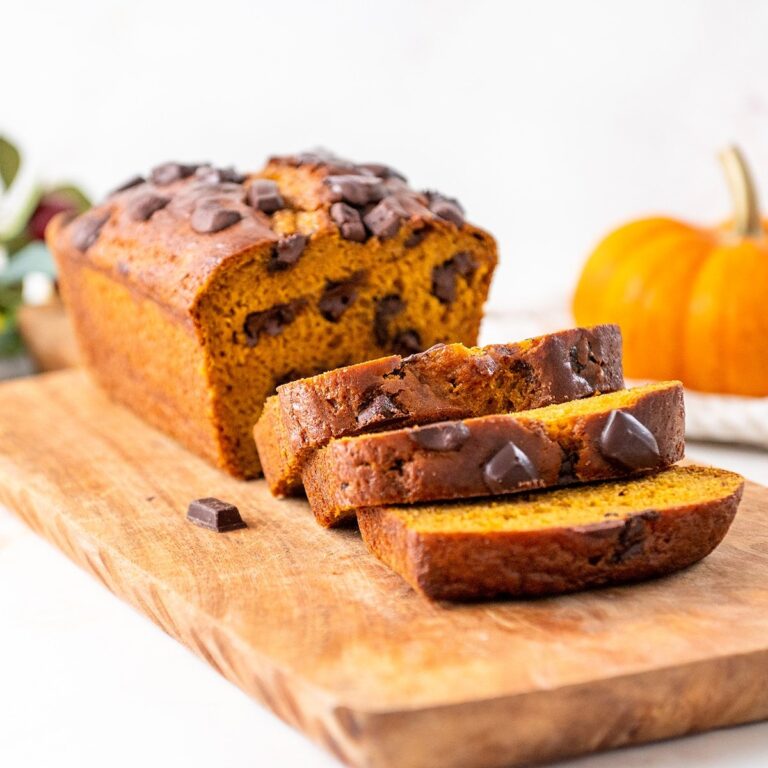
Vegan Pumpkin Bread
This vegan pumpkin bread is rich, moist, and warmly spiced, with deep notes of cinnamon, nutmeg, and clove. Each bite melts in your mouth, delivering cozy autumn flavor balanced by the natural sweetness of pumpkin and a subtle earthiness. When studded with chocolate chips, it adds just the right touch of indulgence and crunch.
History of Pumpkin Bread
From Field to Hearth: The Colonial Roots of Pumpkin Bread
Pumpkin bread has a history as rich and comforting as its flavor. It first rose to popularity in early American kitchens, where European settlers eagerly embraced the pumpkin—one of the most abundant and versatile crops of the New World. Pumpkins weren’t just easy to grow; they stored well and could be used in everything from stews to sweets. Naturally, colonists began experimenting, blending mashed pumpkin into bread dough as a way to stretch their ingredients and add moisture to their loaves.
As they baked more, they discovered that pumpkin not only gave bread a soft texture but also a subtle, earthy sweetness. Slowly but surely, the recipe began to evolve. Colonists added local sweeteners like maple syrup or molasses, along with nuts and seeds for texture. These early pumpkin breads weren’t quite like the ones we enjoy today, but they laid the foundation for something lasting.
Spiced, Sweet, and Timeless: Pumpkin Bread Finds Its Place
Then, as the 19th century unfolded, pumpkin bread found its way into American cookbooks. Bakers began enhancing the flavor with warm spices—cinnamon, nutmeg, ginger, and clove—turning this once-simple loaf into a seasonal favorite. Thanks to improved ovens and more readily available ingredients, pumpkin bread became easier to prepare and more popular across the country.
Eventually, by the 20th century, canned pumpkin entered the scene. This innovation made baking pumpkin bread even more convenient, helping it secure a permanent spot in fall baking traditions. From church potlucks to Thanksgiving tables, pumpkin bread became a symbol of comfort and home.
Today, the story continues. Whether it’s made vegan, gluten-free, or loaded with chocolate chips, pumpkin bread keeps adapting while still delivering the cozy, spiced flavor that generations have loved.
If you want to find out more about the history of title, here is where I found some of my information!
This post may contain affiliate links. See full disclosure here.
Ingredients & Substitutes
- Gluten-free flour with xanthan gum
- Baking powder
- Baking soda
- Salt
- Sugar
- Ground cinnamon
- Nutmeg
- Ground cloves
- Chocolate chips or raisins
- Pumpkin purée
- Brown sugar
- Instant egg replacer (equivalent to 4 eggs)
- Non-dairy milk
- Vanilla
How to Make Vegan Pumpkin Bread
In a large mixing bowl, whisk together all the dry ingredients until they’re evenly combined and aromatic.
Next, pour in the wet ingredients and stir vigorously until the batter is smooth and cohesive. Make sure there are no dry spots or lumps left behind.
Grab two 9×5-inch loaf pans and lightly oil them. Then, divide the batter evenly between the pans, smoothing out the tops with a spatula.
Slide the pans into a preheated 350°F oven. Bake for about 1 hour, or until a toothpick inserted in the center comes out clean.
Once baked, remove the pans from the oven and let the loaves cool for about 10 minutes. Then, carefully transfer them to a wire rack to cool completely before slicing.

Common Questions
1. Does vegan pumpkin bread taste different from regular pumpkin bread?
Not really! In fact, most people can’t even tell the difference. Because pumpkin is naturally moist and flavorful, it helps create a soft, rich texture without needing eggs or dairy. As a result, you still get the same warmly spiced, sweet flavor in every bite.
2. How do you replace eggs in vegan pumpkin bread?
There are several great options. For instance, you can use commercial egg replacers, ground flaxseed mixed with water, or even unsweetened applesauce. Each choice binds the ingredients while keeping the loaf tender and moist.
3. What kind of non-dairy milk works best?
Oat, rice, and hemp milk all work well. Choose whichever one you prefer—just make sure it’s unsweetened so the bread doesn’t turn out overly sweet.
4. How should I store vegan pumpkin bread?
Once it’s cooled, wrap the loaf tightly or place it in an airtight container. Then, store it at room temperature for up to three days—or refrigerate it to keep it fresh even longer. For extended storage, you can freeze individual slices and reheat them as needed.
5. Why did my bread sink or turn out gummy?
That often happens when there’s too much moisture or the batter is overmixed. Next time, try measuring the pumpkin puree carefully, mix the batter just until combined, and don’t overbake. A quick toothpick check near the end of baking helps ensure it’s cooked through.
Other Favorite Allergy Friendly Bread Recipes








Vegan Pumpkin Bread (Gluten, Nut, Soy Free)
I’ll let this recipe speak for itself…. SO YUMMY … Makes 2 9×5 loafs
- Total Time: 1 hour 12 minutes
- Yield: 2 Loaves 1x
Ingredients
- 4 cups gf flour w/ xantham gum
- 2 tsp baking powder
- 1 tsp baking soda
- 1 tsp salt
- 2.5 cup sugar
- 2 tsp ground cinnamon
- 1/2 tsp nutmeg
- 1/4 tsp ground cloves
- 1 cup chocolate chips or raisins
- 2 15oz cans pumpkin puree
- 1 cup brown sugar
- 4 servings instant egg replacer
- 1/2 cup non dairy milk
- 1 TB vanilla
Instructions
- Mix all dry ingredients, then mix in wet ingredients till mixture is smooth.
- Divide batter equally into two lightly oiled 9×5 bread pans.
- Bake @ 350 for 1 hour, or till toothpick comes out clean.
- Prep Time: 12 Min
- Cook Time: 1 Hour

